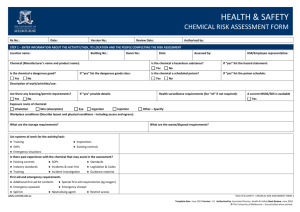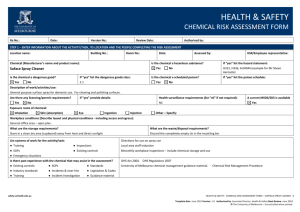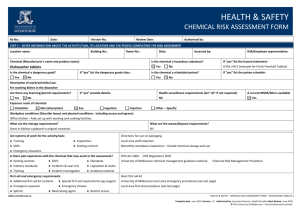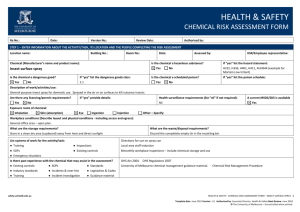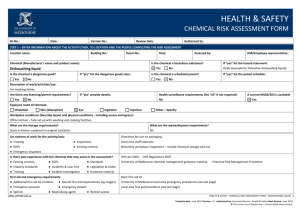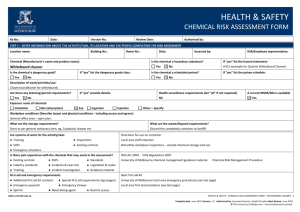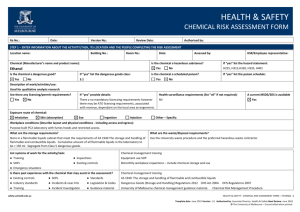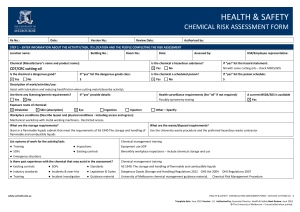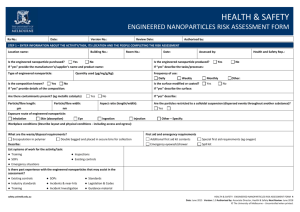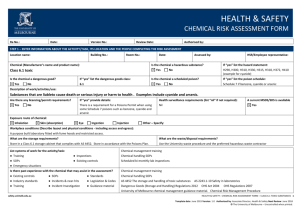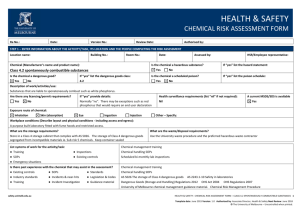Hydrofluoric Acid Risk Assessment Form - Safety
advertisement
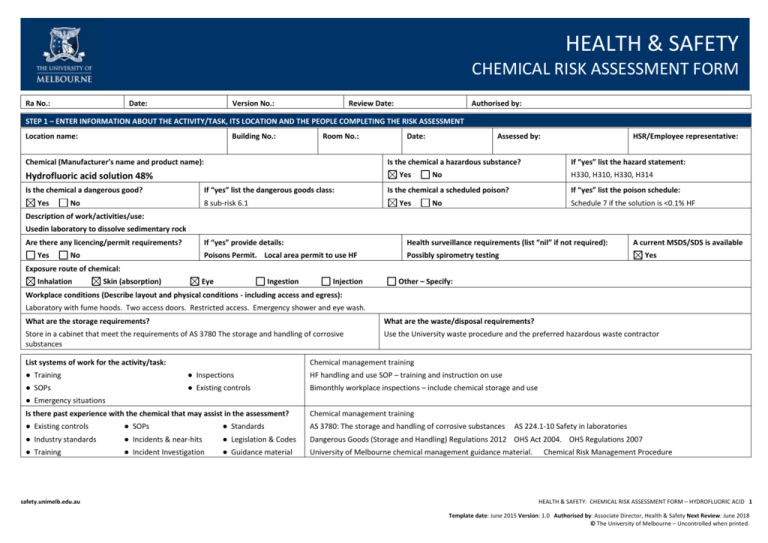
HEALTH & SAFETY CHEMICAL RISK ASSESSMENT FORM Ra No.: Date: Version No.: Review Date: Authorised by: STEP 1 – ENTER INFORMATION ABOUT THE ACTIVITY/TASK, ITS LOCATION AND THE PEOPLE COMPLETING THE RISK ASSESSMENT Location name: Building No.: Room No.: Chemical (Manufacturer’s name and product name): Yes Is the chemical a dangerous good? If “yes” list the dangerous goods class: No Assessed by: Is the chemical a hazardous substance? Hydrofluoric acid solution 48% Yes Date: 8 sub-risk 6.1 No If “yes” list the hazard statement: H330, H310, H330, H314 Is the chemical a scheduled poison? Yes HSR/Employee representative: If “yes” list the poison schedule: No Schedule 7 if the solution is <0.1% HF Description of work/activities/use: Usedin laboratory to dissolve sedimentary rock Are there any licencing/permit requirements? Yes No If “yes” provide details: Health surveillance requirements (list “nil” if not required): Poisons Permit. Local area permit to use HF Possibly spirometry testing A current MSDS/SDS is available Yes Exposure route of chemical: Inhalation Skin (absorption) Eye Ingestion Injection Other – Specify: Workplace conditions (Describe layout and physical conditions - including access and egress): Laboratory with fume hoods. Two access doors. Restricted access. Emergency shower and eye wash. What are the storage requirements? What are the waste/disposal requirements? Store in a cabinet that meet the requirements of AS 3780 The storage and handling of corrosive substances Use the University waste procedure and the preferred hazardous waste contractor List systems of work for the activity/task: Chemical management training ● Training ● Inspections HF handling and use SOP – training and instruction on use ● SOPs ● Existing controls Bimonthly workplace inspections – include chemical storage and use ● Emergency situations Is there past experience with the chemical that may assist in the assessment? Chemical management training ● Existing controls ● SOPs ● Standards AS 3780: The storage and handling of corrosive substances ● Industry standards ● Incidents & near-hits ● Legislation & Codes Dangerous Goods (Storage and Handling) Regulations 2012 OHS Act 2004. OHS Regulations 2007 ● Training ● Incident Investigation ● Guidance material University of Melbourne chemical management guidance material. safety.unimelb.edu.au AS 224.1-10 Safety in laboratories Chemical Risk Management Procedure HEALTH & SAFETY: CHEMICAL RISK ASSESSMENT FORM – HYDROFLUORIC ACID 1 Template date: June 2015 Version: 1.0 Authorised by: Associate Director, Health & Safety Next Review: June 2018 © The University of Melbourne – Uncontrolled when printed. First aid and emergency requirements Burns and eye module for first aid kit ● Additional first aid kit contents ● Special first aid requirements (eg oxygen) Vermiculite or Attapulgite absorbent material ● Emergency eyewash ● Emergency shower University of Melbourne local area emergency procedures (see last page) ● Spill kit safety.unimelb.edu.au ● Neutralising agent ● Restrict access Sodium hydrogen carbonate or sodium anhydrous as neutralisers Local area first aid procedures (see last page) Calcium gluconate gel HEALTH & SAFETY: CHEMICAL RISK ASSESSMENT FORM – HYDROFLUORIC ACID 2 Template date: June 2015 Version: 1.0 Authorised by: Associate Director, Health & Safety Next Review: June 2018 © The University of Melbourne – Uncontrolled when printed. STEP 2: SELECT A RISK RATING METHOD TWO VARIABLE RISK MATRIX THREE VARIABLE RISK CALCULATOR (1) Definitions of likelihood labels (1) Definitions of exposure variables Likelihood (Probability) Level Descriptor Description Exposure E Expected to occur Continuously or many times daily 10 6 A Almost certain The event will occur on an annual basis Once a year or more Frequently: Approximately once daily B Likely The event has occurred several times or more in your career Once every three years Occasionally: Once a week to once a month 3 Infrequently: Once a month to once a year 2 C Possible The event might occur once in your career Once every 10 years Rarely: Has been known to occur 1 D Unlikely The event does occur somewhere from time Once every 30 years to time Very rarely: Not known to have occurred 0.5 E Rare Heard of something like the event occurring elsewhere (2) Definitions of likelihood variables Once every 100 years (2) Definitions of consequence labels Severity level Consequences V Catastrophe One or more fatalities and/or severe irreversible disability to one or more people IV Major Extensive injury or impairment to one or more persons III Moderate Short term disability to one or more persons II Insignificant Medical treatment and/or lost injury time <2 weeks I Negligible First aid treatment or no treatment required Likelihood L Almost certain: The most likely outcome if the event occurs 10 Likely: Not unusual, perhaps 50-50 chance 6 Unusual but possible: (e.g. 1 in 10) 3 Remotely possible: A possible coincidence (e.g. 1 in 100) 1 Conceivable: Has never happened in years of exposure, but possible (eg 1 in 1,000) 0.5 Practically impossible: Not to knowledge ever happened anywhere (e.g. 1 in 10,000) 0. 1 (3) Definitions of consequence variables (3) Risk rating matrix Likelihood Consequence label label I II III IV V A Medium High High Very high Very high B Medium Medium High High Very high C Low Medium High High High D Low Low Medium Medium High E Low Low Medium Medium High Consequences C Catastrophe: Multiple fatalities 100 Disaster: Fatality 50 Very serious: Permanent disability/ill health 25 Serious: Non-permanent injury or ill health 15 Important: Medical attention needed 5 Noticeable: Minor cuts and bruises or sickness 1 (4) Risk score calculator Risk Score = E x L x C safety.unimelb.edu.au Risk score Risk rating > 600 Very high 300 - 599 High 90 - 299 Medium < 90 Low HEALTH & SAFETY: CHEMICAL RISK ASSESSMENT FORM – HYDROFLUORIC ACID 3 Template date: June 2015 Version: 1.0 Authorised by: Associate Director, Health & Safety Next Review: June 2018 © The University of Melbourne – Uncontrolled when printed. STEP 3 – REVIEW CHEMICAL PROCESS For each stage of the chemical risk assessment: Hierarchy of Control (Control Type) Review the prompts/examples for each route of exposure for each category; El – Elimination Determine and record a raw risk score by referencing the two variable risk matrix or the three variable risk calculator; S – Substitution In the comments box, describe the route of exposure and any other information (if applicable); En – Engineering Specify the risk control type for each current or proposed risk control; Sh – Shielding Provide a control description for each current or proposed risk control; A – Administrative T – Training Where proposed risk control(s) have been identified complete a Health & Safety Action Plan; M – Monitoring Determine the residual risk score referencing the same two variable risk matrix or three variable risk calculator used to determine the raw risk score. P – PPE Category Raw Risk Score Storage Is – Isolation G – Guarding In – Inspection H – Health Monitoring For information devising appropriate controls, refer to: Guide to Chemical Risk Hierarchy of Control. Comments (when/where the exposure is present) Control Type Control Description (Current and Proposed) Residual Risk Score 1 x 1 x 50 Skin and eye absorption – by interfering with body En Keep container tightly closed. Store in original container. Low ● Inhalation ● Skin (absorption = 50 calcium metabolism, the concentrated acid may also Is ● Eye ● Ingestion Low cause systemic toxicity and eventual cardiac arrest In ● Injection ● Other and fatality A Chemical burns to eyes If unable to store in original container – HF must be stored in polyethylene, polypropylene, Teflon, wax, lead or platinum containe rs. Store in a cabinet that meets the requirements of AS 3780 Severe lung irritant Regular scheduled inspections 2 x 1 x 50 Skin and eye absorption – by interfering with body En Use as per standard operating procedures ● Skin (absorption = 300 calcium metabolism, the concentrated acid may also A Handle only in a fume hood designated for HF ● Eye ● Ingestion High cause systemic toxicity and eventual cardiac arrest T Chemical management training ● Injection ● Other and fatality P Wear appropriate eye and face protection, protective clothing and gloves as per MSDS/SDS Handling ● Inhalation Chemical burns to eyes Low Other PPE as determined by activity/use and MSDS/SDS (see last page for details of commonly used PPE) Severe lung irritant Decanting/Mixing 2 x 3 x 50 Skin and eye absorption – by interfering with body E Purchase very small quantities to elimnate decanting ● Inhalation ● Skin (absorption = 300 calcium metabolism, the concentrated acid may also En ● Eye ● Ingestion High cause systemic toxicity and eventual cardiac arrest Is Where stock solutions being made etc. procdures and controls as per “Applying/Using” ● Injection ● Other and fatality A Chemical burns to eyes T Severe lung irritant P Medium Fatal if ingeted safety.unimelb.edu.au HEALTH & SAFETY: CHEMICAL RISK ASSESSMENT FORM – HYDROFLUORIC ACID 4 Template date: June 2015 Version: 1.0 Authorised by: Associate Director, Health & Safety Next Review: June 2018 © The University of Melbourne – Uncontrolled when printed. Category Raw Risk Score Comments (when/where the exposure is present) Control Type Control Description (Current and Proposed) Residual Risk Score Medium Applying/Using 6 x 3 x 50 Skin and eye absorption – by interfering with body En Use as per standard operating procedures ● Inhalation ● Skin (absorption = 900 calcium metabolism, the concentrated acid may also In Use in a fume hood designated for HF use ● Eye ● Ingestion Very high cause systemic toxicity and eventual cardiac arrest Is Chemical management training. and fatality A Chemical burns to eyes T HF must be used in polyethylene, polypropylene, Teflon, wax, lead or platinum containers. Severe lung irritant P ● Injection ● Other Fatal if ingeted Wear appropriate eye and face protection, protective clothing and gloves (nitrile or neoprene) as per MSDS/SDS Other PPE as determined by activity/use and MSDS (see last page for details of commonly used PPE) Use in bunded area Regualr scheduled inspections Restricted access 1 x 1 x 50 Skin and eye absorption – by interfering with body Is ● Skin (absorption = 50 calcium metabolism, the concentrated acid may also A Have appropriate spill kit and cleanup equipment available ● Eye ● Ingestion Low cause systemic toxicity and eventual cardiac arrest T SOP for cleaning up spills/leaks ● Injection ● Other and fatality P Wear appropriate eye and face protection, protective clothing and gloves (nitrile or neoprene) as per emergency procedures Spill/Leak ● Inhalation Chemical burns to eyes Severe lung irritant Low Know local emergency procedures and evacuation routes Fatal if ingeted Know the location of first aid kits and the local first aid providers Use undamaged original container or containers appropriate to hold the chemical HF container in bunding Disposal 1 x 1 x 50 Skin and eye absorption – by interfering with body A ● Inhalation ● Skin (absorption = 50 calcium metabolism, the concentrated acid may also Is Use the University of Melbourne preferred hazardous waste contractor ● Eye ● Ingestion Low cause systemic toxicity and eventual cardiac arrest T Store in dedicated area prior to disposal ● Injection ● Other and fatality Chemical burns to eyes Low Local area emergency procedures Restricted access Severe lung irritant safety.unimelb.edu.au HEALTH & SAFETY: CHEMICAL RISK ASSESSMENT FORM – HYDROFLUORIC ACID 5 Template date: June 2015 Version: 1.0 Authorised by: Associate Director, Health & Safety Next Review: June 2018 © The University of Melbourne – Uncontrolled when printed. STEP 4 – IMPLEMENTATION AND CONSULTATION PROCESS Determine the person responsible for reviewing and implementing the risk assessment including the identified controls. Ensure a Health & Safety Action Plan has been completed, reviewed and signed off where proposed controls have been identified. Obtain the authorisation of the management representative. Ensure the HSR (if applicable) has been consulted. Ensure the employees undertaking the activity have been consulted. Record below the names of the persons consulted. Management representative HSR/Employee representative Employee(s) Employee(s) Employee(s) Employee(s) Person Responsible for implementation or escalation Extra writing room - use this page to enter extended comments or descriptions Review: Review risk assessment every 3 years. Review employee chemical procedures during workplace inspections. Review risk assessment where there is an incident with the chemical or new information becomes available. Review risk assessment when the MSDS/SDS is updated/reissued. Emergency and First Aid procedures Ensure that general first aid procedures and resources are in place and available. First aid risk assessment and procedures that take into account the risks associated with the chemical and possible adverse outcomes. Calium gluconate gel for dermal contact University of Melbourne and local area emergency procedures. Spill kits – vermiculite or attapulgite. Sodium hydrogen hydrogen carbonate or sodium anhydrous as neutraliser. PPE Respiratory protection: AS/NZS 1715 Selection, use and maintenance of respiratory protective equipment Safety Glasses: AS/NZS 1337.1 Personal eye protection. Eye and face protectors for occupational applications Gloves: AS/NZS 2161.1 Occupational protective glove. Selection, use and maintenance Boots: AS/NZS 2210.1-9 (series) Occupational protective footwear or sturdy footwear as per local area requirements To eliminate injuries always use the chemical in accordance with the manufacturer’s instructions and for its intended purpose only. All chemical users must have demonstrated competency and be familiar with the risk assessment and any SOPs prior to use of the chemical. For use in conjunction with the OHS risk management procedure and the Chemical risk management procedure. For further information, refer to http://safety.unimelb.edu.au/tools/risk/ or contact your Local Health & Safety contact. safety.unimelb.edu.au HEALTH & SAFETY: CHEMICAL RISK ASSESSMENT FORM – HYDROFLUORIC ACID 6 Template date: June 2015 Version: 1.0 Authorised by: Associate Director, Health & Safety Next Review: June 2018 © The University of Melbourne – Uncontrolled when printed.
